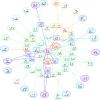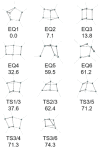Implementation and performance of the artificial force induced reaction method in the GRRM17 program
- PMID: 29135034
- PMCID: PMC5765425
- DOI: 10.1002/jcc.25106
Implementation and performance of the artificial force induced reaction method in the GRRM17 program
Abstract
This article reports implementation and performance of the artificial force induced reaction (AFIR) method in the upcoming 2017 version of GRRM program (GRRM17). The AFIR method, which is one of automated reaction path search methods, induces geometrical deformations in a system by pushing or pulling fragments defined in the system by an artificial force. In GRRM17, three different algorithms, that is, multicomponent algorithm (MC-AFIR), single-component algorithm (SC-AFIR), and double-sphere algorithm (DS-AFIR), are available, where the MC-AFIR was the only algorithm which has been available in the previous 2014 version. The MC-AFIR does automated sampling of reaction pathways between two or more reactant molecules. The SC-AFIR performs automated generation of global or semiglobal reaction path network. The DS-AFIR finds a single path between given two structures. Exploration of minimum energy structures within the hypersurface in which two different electronic states degenerate, and an interface with the quantum mechanics/molecular mechanics method, are also described. A code termed SAFIRE will also be available, as a visualization software for complicated reaction path networks. © 2017 The Authors. Journal of Computational Chemistry Published by Wiley Periodicals, Inc.
Keywords: QM/MM; intrinsic reaction coordinate; nonadiabatic transition; potential energy surface; transition state.
© 2017 The Authors. Journal of Computational Chemistry Published by Wiley Periodicals, Inc.
Figures














Similar articles
-
Exploring transition state structures for intramolecular pathways by the artificial force induced reaction method.J Comput Chem. 2014 Jan 15;35(2):166-73. doi: 10.1002/jcc.23481. Epub 2013 Nov 1. J Comput Chem. 2014. PMID: 24186858
-
Computational Catalysis Using the Artificial Force Induced Reaction Method.Acc Chem Res. 2016 Apr 19;49(4):763-73. doi: 10.1021/acs.accounts.6b00023. Epub 2016 Mar 29. Acc Chem Res. 2016. PMID: 27023677
-
Artificial Force Induced Reaction (AFIR) Method for Exploring Quantum Chemical Potential Energy Surfaces.Chem Rec. 2016 Oct;16(5):2232-2248. doi: 10.1002/tcr.201600043. Epub 2016 Jun 3. Chem Rec. 2016. PMID: 27258568
-
Exploration of Carbon Allotropes with Four-membered Ring Structures on Quantum Chemical Potential Energy Surfaces.J Comput Chem. 2019 Jan 5;40(1):14-28. doi: 10.1002/jcc.25556. Epub 2018 Oct 3. J Comput Chem. 2019. PMID: 30284308 Review.
-
Advances in Docking.Curr Med Chem. 2019;26(42):7555-7580. doi: 10.2174/0929867325666180904115000. Curr Med Chem. 2019. PMID: 30182836 Review.
Cited by
-
Strain-Releasing Ring-Opening Diphosphinations for the Synthesis of Diphosphine Ligands with Cyclic Backbones.JACS Au. 2024 Jul 29;4(10):3777-3787. doi: 10.1021/jacsau.4c00347. eCollection 2024 Oct 28. JACS Au. 2024. PMID: 39483215 Free PMC article.
-
Tetraborylation of p-Benzynes Generated by the Masamune-Bergman Cyclization through Reaction Design Based on the Reaction Path Network.JACS Au. 2024 Jun 20;4(7):2578-2584. doi: 10.1021/jacsau.4c00302. eCollection 2024 Jul 22. JACS Au. 2024. PMID: 39055142 Free PMC article.
-
Mining hydroformylation in complex reaction network via graph theory.RSC Adv. 2021 Jul 1;11(38):23235-23240. doi: 10.1039/d1ra03395f. eCollection 2021 Jul 1. RSC Adv. 2021. PMID: 35479801 Free PMC article.
-
Designing main-group catalysts for low-temperature methane combustion by ozone.Nat Commun. 2023 Jul 3;14(1):3926. doi: 10.1038/s41467-023-39541-y. Nat Commun. 2023. PMID: 37400448 Free PMC article.
-
Global Reaction Route Mapping of C3H2O: Isomerization Pathways, Dissociation Channels, and Bimolecular Reaction with a Water Molecule.Molecules. 2025 Apr 18;30(8):1829. doi: 10.3390/molecules30081829. Molecules. 2025. PMID: 40333843 Free PMC article.
References
-
- Schlegel H. B., J. Comput. Chem. 2003, 24, 1514. - PubMed
-
- Jensen F., Introduction to Computational Chemistry, 2nd ed.; Wiley: Chichester, UK, 2007.
-
- Fukui K., Acc. Chem. Res. 1981, 14, 363.
-
- Maeda S., Harabuchi Y., Ono Y., Taketsugu T., Morokuma K., Int. J. Quantum Chem. 2015, 115, 258.
-
- Harvey J. N., WIREs Comput. Mol. Sci. 2014, 4, 1.
Publication types
LinkOut - more resources
Full Text Sources
Other Literature Sources

